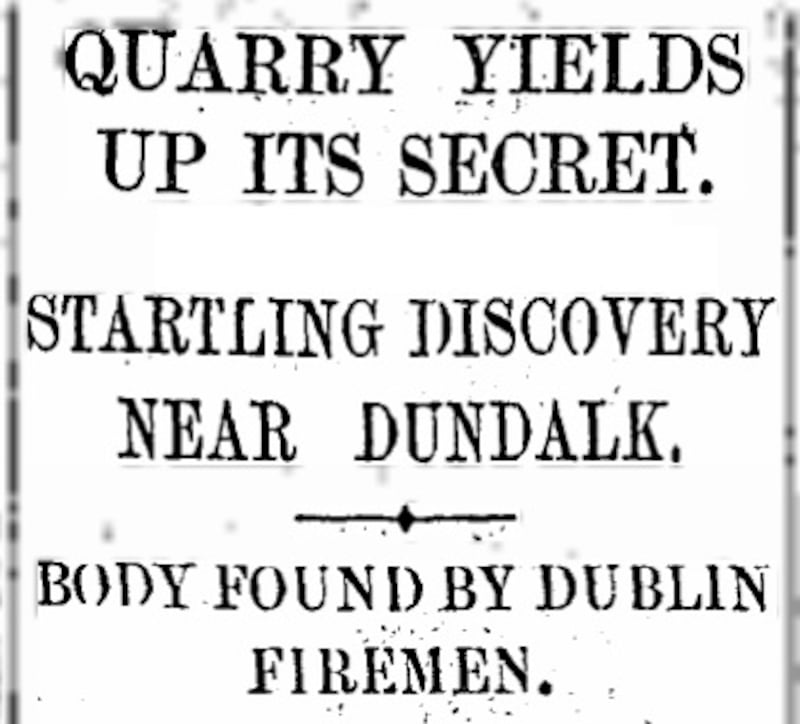After four days of endlessly dredging the old quarry at Kilcurry, Co Louth, a black bundle was spotted near the surface of the water. As dawn broke, two gardaí and a fireman waded out to the object.
Using poles, they brought ashore what appeared to be a sack, sewn closed and tied at the top with the arm of a shirt. They pulled open the parcel, revealing the carefully butchered remains of a young woman. Heavy stones lined the bag.
The body was badly decomposed, making a quick identification impossible. Leo Farnon, a dentist at Dundalk, helped solve that mystery when he recognised the false teeth as a set he made years before for a young woman; 35-year old housekeeper, Mary Callan.

On Monday, May 16th, 1927 - about a year before the discovery of the body - Faughart parish priest Fr McKeone readied himself for a journey to Dublin. Leaving the parochial house for Dundalk railway station, he spotted Ms Callan, his employee of two years, standing over the wash tub in the kitchen.
Gerard Toal, an 18-year-old servant to the priest and his only other worker, drove the clergyman to catch the 12pm train. Toal was a small, slight, young man from Blackrock, near Dundalk. Both his parents were dead and before working for the priest, he had been an inmate of the industrial school in Artane in Dublin.
When the priest’s return train pulled in eight hours later, Toal was dutifully waiting to take him back. The sun had not yet set when the pair entered the house to discover the fire unlit. Mary was nowhere to be found, and her bicycle was gone.
Fr McKeone became impatient, according to a report in The Irish Times on June 22nd, 1928, and went through each room of the house. Nothing else seemed missing.
Toal, for his part, told the priest he hadn’t seen her leave; the last he saw of her, she had called him in for his dinner that afternoon. At the time, she told the young servant she intended to go out. “Mary’s mother must be sick,” the priest concluded, “and she will probably be back in the morning.”
When she didn’t return the next day, Fr McKeone had Toal throw together a breakfast - a job outside his normal duties - and sent him in the motor car to Mary’s mother’s house, about 20km northwest, in Collaville.
He saw the girl sitting at the kitchen fire, talking loudly to herself
When Toal returned with the news that Mary hadn’t been to her mother’s house, the priest said he was astonished, according to the report. As Toal turned to walk away from the priest, he said in a low voice: “Father, there must have been something wrong with Mary when she went away.”
In the days following Mary’s disappearance, the priest again questioned Toal, who stayed true to his story. The priest asked the young servant if she had been acting strangely.
‘Talking loudly to herself’
"Toal replied that one evening when he came to the kitchen door he found it closed, and on looking through the window he saw the girl sitting at the kitchen fire, talking loudly to herself, and moving her arms and hands about," according to an Irish Times report.
It was no secret that Toal and Mary did not get on. Relations between the two had been strained, owing, among other spats, to Mary accusing Toal of stealing eggs. At the time of her disappearance, he was questioned by a garda, who said “he did not entertain the slightest suspicion at the time that there had been any foul play.”
After Mary disappeared, life returned somewhat to normal at Fr McKeone’s house; another housekeeper and close friend of Mary’s, Peggy Gallagher, came to stay.
However, Toal’s behaviour began to change. The priest recalled catching him burning various pieces of paper in his room, which he kept locked. A blanket, which the priest recognised as belonging to Mary, was a found in his room - Peggy also recognised the blanket, along with a prayer book and Mary’s favourite wrist watch.
In March the priest raided Toal’s room, where he discovered a number of watches and parts of a ladies’ bicycle. Peggy, too, had recognised the handlebars. Fr McKeone confronted Toal, who said he bought the parts in Dundalk, but after being accused of lying by the priest, later changed his story, claiming he stole the parts. The watches, he said, were purchased legitimately.
Fr McKeone told police about the allegedly stolen bicycle parts and later gave Toal his notice. The young man was putting a plan in place to leave for Canada when Mary's body was discovered, and suspicion turned to him. Toal was arrested and charged with murder on June 4th, 1928.
Did you murder Mary Callan?
At the trial, evidence against him was circumstantial - burnt remnants of clothes, Mary’s items in his possession, an alleged handiness in butchery, apparently garnered from his time in Artane - though that would be strenuously denied by the defence.
The jury heard of the animosity between Toal and Mary. They heard how he had a keen interest in martial arts, and had boasted he could perform a move that could kill a man.
Handlebars
The bicycle parts became integral, after a Dundalk bicycle maker identified distinct saw marks on the handlebars. Without a doubt, they came from Mary Callan’s bicycle.
The same condemnation came from a watchmaker, who recognised the watch and said although he couldn’t remember who initially bought it, he last saw it in his shop when it was brought in for repairs - by Mary Callan.
On the final day of the trial, July 26th, his counsel, Mr Roe, asked him straight: “Did you murder Mary Callan?”
"I did not murder Mary Callan," Toal replied, with emphasis, according to the Irish Times reporter.
Toal tried to explain away the items found in his room. But Mr Carrigan, for the prosecution, wondered about the prayer book in particular: why write his own name on it, unless he knew Mary was dead?
Carrigan: “How do you explain taking the prayer book of a living woman and putting your name in it?”
Toal: “If she turned up I would have given it to her.”
Carrigan: “If she returned?”
Toal: “Yes.”
Carrigan, quoting Hamlet: "From that bourne from which no traveller returneth."
The jury asked the judge if they could find Toal guilty of manslaughter, presuming he had attacked Mary, but not intended to kill her. The judge rejected the possibility and Toal was found guilty of murder.
“I am not guilty,” said Toal in a low voice, when asked if he had anything to say.
A few weeks later, on the morning of August 29th, people gathered outside the gates of Mountjoy. Women, girls and a single barefooted boy knelt in the street and recited the rosary; likely for a late reprieve for the young man.
Toal had spent his time as a condemned man in a calm state, sometimes playing draughts with the warders. According to the Drogheda Independent, his conduct was nothing short of "exemplary".
Just before 8am, Toal walked firmly to the scaffold by all accounts and was pinioned without hassle. As the prison bell struck the hour, Tom Pierrepoint pulled the lever. Toal's death, according to the inquest, was quick.
A few minutes after 8am, a notice was posted on the outer prison door confirming the execution. The crowd, numbering about 100 by then, dispersed.
This story is part of the Lost Leads series - a revisiting of lesser-known stories that have made the pages of The Irish Times since 1859. What can you find? Let us know on Twitter: @irishtimes or @deanruxton. For more information on subscribing to the archive, see www.irishtimes.com/archive













